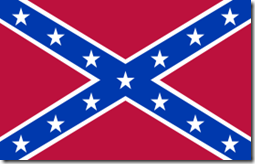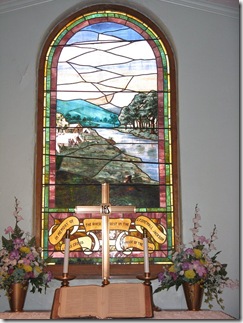
I am interested in knowing what comes over you when you see the Confederate flag? As someone who is studying the Civil War, grew up in Virginia where the flag was displayed by many—and even seeing that flag on many vehicles here in Kentucky, I am curious as to what your reaction is in seeing this flag? (This is the Confederate Navy Jack, and also the flag of the Army of Tennessee which became the battle flag for the Confederacy during the American Civil War from 1861-1865).
Here’s a Wikipedia article on why many display this flag
The display of the Confederate flag remains a highly controversial and emotional topic, generally because of disagreement over the nature of its symbolism.
Opponents of the Confederate flag see it as an overt symbol of racism (especially directed toward African Americans), both for the history of racialslavery in the United States, and the establishment of Jim Crow laws bySouthern states following the end of Reconstruction in late 1870s, enforcingracial segregation within state borders for nearly a century until the Civil Rights Movement. Some hate groups use the Southern Cross as one of thesymbols associated with their organizations, including racist groups such as the Neo-Nazis and the Ku Klux Klan.[18] The flag is also sometimes used by separatist organizations such as the Aryan Nations. The Aryan Nation also uses the U.S. flag as well as the Christian flag displayed in some Protestant churches.
Supporters of the flag view it as a symbol of heritage and the freedom of the distinct cultural tradition of the South from the oppression of Northern government. Also, in light of some schools and universities banning it as a racist symbol "speech codes", it could also be seen as a symbol of freedom of speech.[19]
White southerners often claim that they see the flag as merely a symbol of southern culture without any political or racial connotation. An example of this would be the Bocephus Rebel Flag often sold at concerts performed bycountry music star Hank Williams, Jr or Kevin Fowler, heavy metal bandPantera, and southern rock band Lynyrd Skynyrd. For some, the flag represents only a past era of southern sovereignty.[20] Some historical societies such as the Sons of Confederate Veterans and the United Daughters of the Confederacy also use the flag as part of their symbols. Also some rockabilly fans hold the Confederate flag as their emblem.[21]Also, the flag is a regular cultural meme, often appearing in association with a character who reflects Southerner stereotypes.
As a result of these varying perceptions, there have been a number of political controversies surrounding the use of the Confederate flag in Southern state flags, at sporting events, at Southern universities, and on public buildings. According to Civil War historian and native SouthernerShelby Foote, the flag traditionally represented the South’s resistance toNorthern political dominance; it became racially charged during the Civil Rights Movement of the 1950s and 1960s, when fighting against desegregation suddenly became the focal point of that resistance.
Symbols of the Confederacy remain a contentious issue across the United States and have been debated vigorously in many Southern state legislatures over their civic placement since the 1990s.
In other countries, the Confederate flag can be used as a symbol for other things. For example, in Sweden it is used by people who drive and enjoy old American cars and enjoy the American life style from the 1940s, 50s, and 60s. In the United Kingdom it is frequently used by people who enjoy line dancing, country music and American life style.So what think ye?
 The Confederate States of America has long held an interest for this ‘son of Virginia,’ ever since my second-grade teacher took us on a field trip to Appomattox. It’s infused in every Virginian the history of his native state. William C. Davis’ book on the last four months of the Confederacy is a marvelous book in giving the grim realities of how ‘the Cause’ flickered out.
The Confederate States of America has long held an interest for this ‘son of Virginia,’ ever since my second-grade teacher took us on a field trip to Appomattox. It’s infused in every Virginian the history of his native state. William C. Davis’ book on the last four months of the Confederacy is a marvelous book in giving the grim realities of how ‘the Cause’ flickered out. 



 This is a window from the Fifth Avenue Presbyterian Church in Roanoke, VA. On it, it depicts the last words of Confederate General Thomas J. “Stonewall” Jackson: “Let us cross over the river, and rest under the shade of the tree”–spoken on May 10, 1863. Oh, one more thing: this is an African-American congregation! The descendants of this church sat under Jackson’s Sunday School class from 1855-1861 when it was illegal in Virginia for blacks to learn how to read and write, making Jackson a lawbreaker. They were so grateful for his work with them that these congregants chose never to forget the legacy of teaching Scripture. Take a
This is a window from the Fifth Avenue Presbyterian Church in Roanoke, VA. On it, it depicts the last words of Confederate General Thomas J. “Stonewall” Jackson: “Let us cross over the river, and rest under the shade of the tree”–spoken on May 10, 1863. Oh, one more thing: this is an African-American congregation! The descendants of this church sat under Jackson’s Sunday School class from 1855-1861 when it was illegal in Virginia for blacks to learn how to read and write, making Jackson a lawbreaker. They were so grateful for his work with them that these congregants chose never to forget the legacy of teaching Scripture. Take a 
